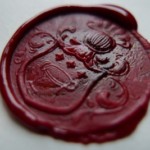Why do we use a Lodge seal?

The word “seal” appears in the “Ahiman Rezon” more than 80 times (not counting the index). That means seals are talked about on one out of every three pages in the Constitution of the Grand Lodge of Pennsylvania. For many, seals seem like quaint anachronisms of an age prior to electronic communication. For others, they represent a cultured experience that is longed for. Obviously, seals are important to our Grand Lodge and to our Fraternity, but why?
To understand the importance of seals, we must first acquaint ourselves with what they are and where they come from. In its most basic format, a seal is an implement used to make a mark on a medium that could not easily be replicated. This includes impression seals, such as those made by stamping wax or clay; embossing seals, used to press designs into paper; stick-on seals, which cannot be removed and are tamper proof; and wrappers that completely cover a product and are not easily replaced. All of these types of seals share on thing in common – they were used to authenticate a document or object and provide evidence of potential tampering.

A Seal of Pressed Wax
The most well-known and often thought of type of seal is used for impressing wax. Wax seals date from the earliest of times, coming into prominent use during the Middle Ages. Popularized by monarchs and Popes, they were used to authenticate documents. If you received a summons from the King with his seal attached, you could be sure the document was authentic. In a time when the average subject may never meet a king, and rulings had to be dispersed and enforced across vast areas, seals provided an efficient method of implying trust in documents.
As the effectiveness of wax seals was discovered, their use moved down the social hierarchy to include nobles, bishops, municipalities and even the common man. This created a great variety of types of seals, from those that resemble stamps, to signet rings and signet watch fobs. The craftsmanship of these seals became a form of art unto themselves that is romanticized to this day.
Wax seals, however, had some problems. First, they were messy, in that the wax had to be melted and applied. Seals could easily accrue a wax build up if not properly cared for, and they were expensive to replace. As technology advanced, rubber stamps and embossers offered an easier method for authenticating documents, and whole industries evolved to handle this process. Today’s Notary Publics, all of whom have an official seal, can trace their roots back to the wax seals of the Middle Ages and before.
Today, most corporate bodies, municipalities and Masonic organizations have embossing / debossing seals in place of wax. These devices, whether hand-held or tabletop, create a three-dimensional seal directly on a piece of paper. Once embossed, it’s almost impossible to remove the design without physical defect. This method thus provides the same effect as a wax seal, without the mess and hassle. Generally, official embossing is done without any additional ink, a technique that is known as “blind embossing.” If ink is added, it’s called “color registered embossing.” Should the embossing be created on a foil stamp, it is referred to as “combination stamping.”

The Seal of the Grand Lodge of Pennsylvania, Free and Accepted Masons
The “Ahiman Rez0n” authorizes the use of two different seals by the officers of the Grand Lodge. First is the Seal of the Grand Lodge itself, used to authenticate transactions and documents produced by the organization, such as certificates of good standing, proceedings and other official transactions. This seal is the one most commonly seen, consisting of the visage of Apollo centered in radiance with the name of the Grand Lodge and the Latin motto “Virtute Silentio Amore,” which translates to “Virtue, Silence, Love.” This seal is entrusted to the Grand Secretary.
The Grand Master of the Grand Lodge is also entitled the use of a personal seal while in office. Section 12.03 of the “Ahiman Rezon” specifically authorizes this with the phrase “To have and use a private seal to attest his acts.” Since 1896, the most well-known seal of the Grand Master has been the signet ring used by Bro. Robert A. Lamberton, Right Worshipful Past Grand Master. The ring, made of gold and engraved with the private seal of the Grand Master, was presented to the Grand Lodge by Bro. Lamberton’s son, on condition that it be passed down from one Grand Master to the next and to be worn on official occasions, when desired.
Furthermore, in Pennsylvania, each Lodge is required to have a seal of its own to authenticate its official documents, including membership information like dues cards and certificates. These seals, usually embossers, are maintained by the Secretary of the Lodge. Some Lodges have begun printing their seals on official documents as well, making replication easier.
Among the fraternity, there is a movement to return to the use of official seals, especially of the wax variety, as it hearkens back to a more refined time in history. Many also enjoy the formality of a wax seal. These seals have become novel in today’s world, creating a new experience for the recipient of documents. In some jurisdictions, Lodges are sending new candidates official notice of the acceptance into the Lodge via highly stylized communications, on high grade paper and with wax seals, in an effort to impress the new candidate and further add solemnity to the process he is about to embark upon.
Seals, whether of wax, embossed or some other material, have been integral to the creation and development of society the world over. Their place in the fraternity has been cemented by their import in official transactions. Today, seals are experiencing a resurgence meant to bring formality to the Lodge.
When was the last time you took a look at your Lodge seal?
Sources:
- Collon, D. (n.d.). 7000 years of seals.
- New, E. (2010). Seals and sealing practices. London: British Records Association.
- The “Ahimon Rezon”








